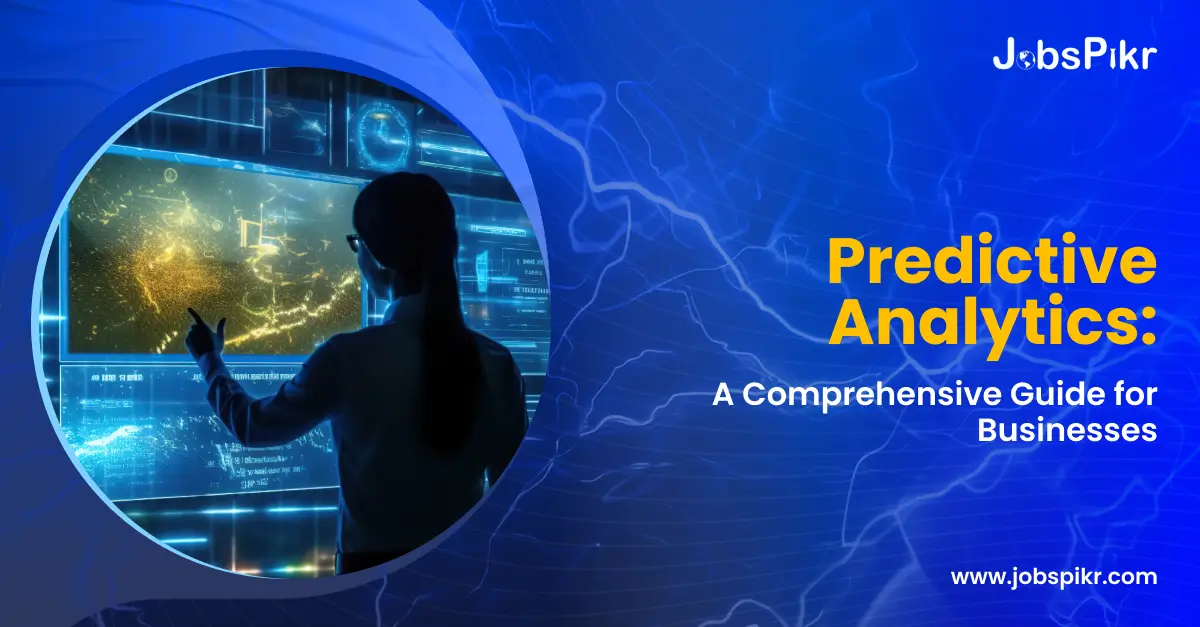What is Predictive Analytics?
Predictive analytics is the process of using historical data, statistical algorithms, and machine learning techniques to identify the likelihood of future outcomes based on historical data. It’s a powerful decision-making tool that allows businesses to anticipate trends, customer behavior, and risks by analyzing large datasets and patterns.
Predictive analytics leverages advanced algorithms to detect relationships and trends that may not be immediately apparent. These models can then be used to forecast everything from consumer buying behaviors to equipment failures in industries such as healthcare, retail, and finance.
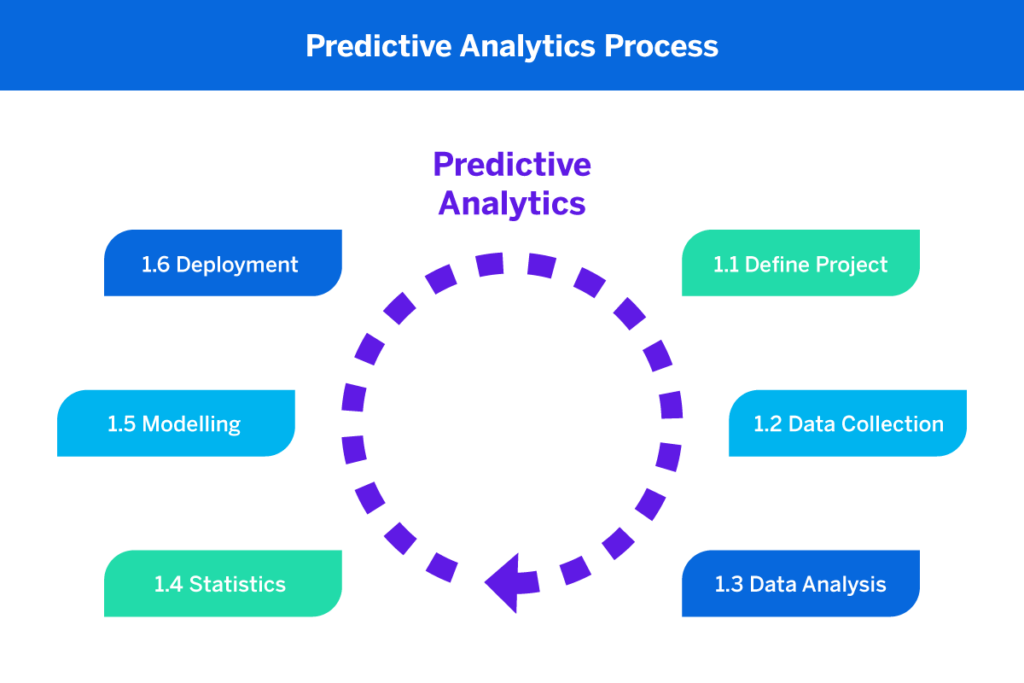
Image Source: Qualtrics
At its core, predictive analytics refers to using historical data to predict future outcomes. This data-driven approach combines techniques from statistics, machine learning, data mining, and artificial intelligence to make informed predictions. Whether it’s predicting customer churn, sales trends, or equipment failures, predictive analytics provides valuable insights into what might happen in the future.
Predictive analytics is built on several fundamental concepts:
- Data Collection: This initial step involves gathering relevant historical data from sources such as databases and customer interactions. Effective data collection is crucial for ensuring the accuracy and richness of predictions.
- Model Building: Analysts create mathematical models that identify historical patterns using algorithms like regression and decision trees. This phase often requires testing and refining models to improve predictive accuracy.
- Analysis: After models are built, they are used to interpret data and extract insights. Analysts evaluate model performance by comparing predictions with actual outcomes, allowing for further refinement and understanding of key trends.
- Prediction: The final step is to use the models to forecast future outcomes. These predictions inform organizational decisions, helping businesses optimize resources and enhance their competitive edge.
History and Evolution
Predictive analytics has its roots in traditional statistical forecasting techniques, but its capabilities have significantly evolved over time. Initially limited to simple forecasting methods, the advent of big data, machine learning, and AI has enabled more complex and accurate predictive models.
Forecasting has been around for decades, with early models relying on historical sales data to predict future trends. However, modern predictive analytics platforms now use real-time data, machine learning algorithms, and big data analytics to create more accurate and dynamic models that can adjust to changing conditions.
How Predictive Analytics Works?
The process typically begins with data collection, which involves gathering historical data relevant to the prediction task. Once the data is prepared and cleaned, data scientists use statistical models, machine learning algorithms, and AI techniques to identify relationships and patterns. These models are then tested for accuracy before being deployed for predictions.
Why Predictive Analytics Matters for Modern Businesses?
Predictive analytics answers the question: “What will happen next?” by analyzing historical data trends and patterns. Unlike descriptive analytics, which looks at what happened, predictive analytics provides a forward-looking perspective, allowing businesses to anticipate changes and make proactive decisions.
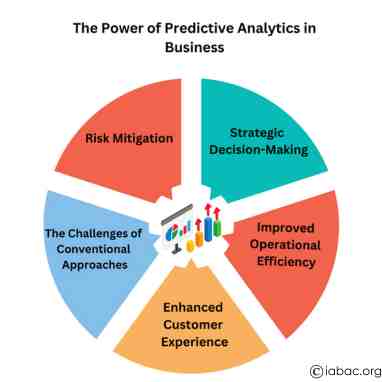
Image Source: IACBAC
Predictive analytics can transform the way businesses operate by enabling:
- Better Decision Making: By leveraging data-driven insights, businesses can forecast trends and adjust strategies proactively. For instance, retailers can anticipate seasonal demand and optimize inventory accordingly.
- Improved Operational Efficiency: Predictive analytics helps organizations foresee potential issues, such as equipment failures, enabling proactive maintenance. This approach minimizes downtime and reduces costs associated with repairs.
- Targeted Marketing Strategies: By analyzing customer data, businesses can segment their audience and tailor marketing campaigns to meet specific needs. This personalization boosts engagement and improves conversion rates.
- Risk Management: Predictive analytics allows organizations to identify and mitigate risks before they escalate. For example, financial institutions can assess credit risk more accurately, leading to better lending decisions.
Why Predictive Analytics is Essential for Decision Making?
Businesses today face increasing uncertainty and competition. Predictive analytics helps minimize risks by providing reliable forecasts and actionable insights. From financial planning to customer acquisition strategies, predictive analytics has become a vital tool for modern business leaders.
Predictive analytics has applications across numerous industries:
- Healthcare: Predictive analytics can significantly enhance patient care by analyzing historical data to predict outcomes. For instance, hospitals use these insights to identify at-risk patients, allowing for timely interventions and personalized treatment plans that improve recovery rates.
- Retail: In the retail sector, predictive analytics helps businesses forecast consumer demand based on historical sales data and market trends. This enables retailers to optimize inventory levels, reduce stockouts, and manage supply chains effectively, ultimately enhancing customer satisfaction and profitability.
- Finance: Financial institutions leverage predictive analytics for risk modeling and fraud detection. By analyzing transaction patterns and customer behaviors, banks can identify potential fraudulent activities and assess credit risks more accurately, leading to improved financial decision-making and security.
- Manufacturing: Predictive maintenance in manufacturing minimizes downtime by using analytics to predict equipment failures before they occur. This proactive approach helps manufacturers schedule timely maintenance, extend machinery lifespan, and improve overall operational efficiency.
Best Predictive Analytics Software for Businesses
Predictive analytics software encompasses platforms and tools that help businesses extract insights from data and predict future trends. These platforms typically offer data visualization, modeling, and machine learning capabilities to support data-driven decisions.
Here are some of the Best Predictive Analytics Software Solutions
1. IBM Watson Analytics
IBM Watson Analytics is an AI-driven platform that simplifies data analysis and visualization. It provides intuitive interfaces for users to uncover insights quickly, utilizing natural language processing to help non-technical users interact with data effectively.
2. SAS Advanced Analytics
SAS Advanced Analytics offers a comprehensive suite of tools for deep data analysis, enabling businesses to apply advanced statistical techniques and machine learning algorithms. It excels in handling complex data sets and provides robust capabilities for predictive modeling and forecasting.
3. Microsoft Azure Machine Learning
Microsoft Azure Machine Learning is a powerful cloud-based platform that facilitates the development and deployment of machine learning models. It integrates seamlessly with various Azure services and offers tools for data preparation, model training, and deployment, making it ideal for businesses seeking scalability.
4. RapidMiner
RapidMiner is an open-source platform that brings together data preparation, machine learning, and model deployment in a user-friendly environment. It supports various data sources and provides extensive functionality for building predictive models without extensive coding knowledge.
5. Tableau
Tableau is renowned for its strong data visualization capabilities, which enhance predictive analytics by allowing users to create interactive dashboards and reports. Its integration with predictive analytics tools makes it easier for organizations to visualize trends and forecast future outcomes.
Which Predictive Analytics Platform is Right for You?
When comparing the best predictive analytics software, businesses should consider the following factors:
- Ease of Use: Evaluate the user interface and whether the platform is designed for both technical and non-technical users.
- Scalability: Ensure that the software can accommodate large datasets and scale alongside business growth and data complexity.
- Integration: Check if the software can easily integrate with existing tools such as CRMs and ERPs to streamline workflows.
- AI and Machine Learning Features: Assess the availability of advanced AI functionalities that enhance predictive capabilities and improve accuracy.
Popular Predictive Analytics Software for Data-Driven Insights
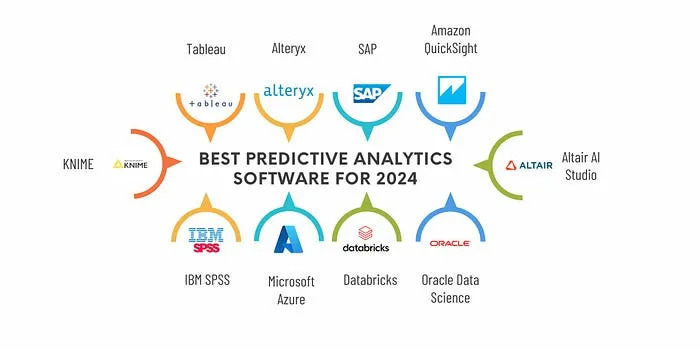
Image Source: Medium
Some of the most popular tools for predictive analytics include:
1. Google Cloud AI
Google Cloud AI harnesses Google’s extensive infrastructure to support large-scale machine learning and data analysis. Its suite of tools is designed to simplify model training and deployment while ensuring high performance for enterprise-level applications.
2. R Programming
R is an open-source programming language favored by data scientists for its statistical computing capabilities. It provides a rich ecosystem of packages for predictive modeling and data visualization, making it a powerful choice for analytical tasks.
3. Python Libraries (SciKit-learn, TensorFlow)
Python’s flexible ecosystem includes libraries like SciKit-learn and TensorFlow, which are essential for predictive analytics. These libraries offer robust frameworks for building machine learning models and conducting data analysis, making Python a preferred language among developers and data scientists.
4. Power BI for Predictive Analytics
Microsoft Power BI is a versatile tool that allows businesses to visualize data and create predictive models. It integrates well with machine learning platforms like Azure Machine Learning, enabling users to forecast future trends directly from their dashboards.
Snowflake Predictive Analytics Capabilities
Snowflake’s cloud-based data platform is highly scalable and designed to handle vast amounts of data. It integrates with machine learning models to provide predictive analytics capabilities for industries like finance and retail.
How Predictive Analytics Methodologies Shape Business Decisions?
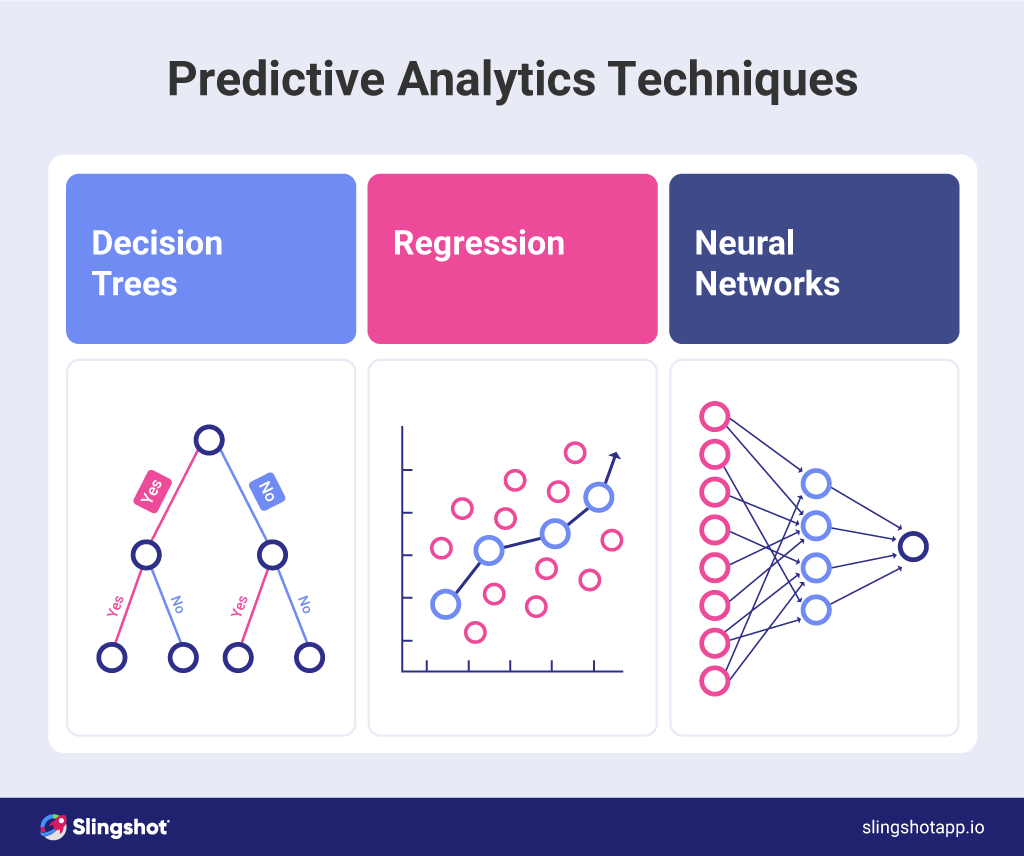
Image Source: Slingshotapp
Predictive analytics relies on a variety of methodologies to build effective models, such as:
- Regression Analysis
- Decision Trees
- Neural Networks
- Time-Series Forecasting
Predictive Analytics Tools and Techniques
Techniques such as decision trees, clustering, and neural networks are commonly used in predictive analytics. These tools help in identifying patterns within the data and creating models that can make accurate predictions.
When selecting predictive analytics software, businesses should consider:
- Automation Capabilities:
Look for software that automates data collection, analysis, and reporting processes. Automation reduces manual effort, minimizes errors, and enables teams to focus on interpreting insights rather than getting bogged down by repetitive tasks. Features like automated data cleaning and model building can significantly enhance efficiency. - Scalability:
Choose a solution that can grow with your business. Scalability is crucial as it ensures that the software can handle increasing amounts of data and user demands without a drop in performance. This is particularly important for organizations anticipating growth or fluctuating data needs. - Ease of Use:
The software should be user-friendly, allowing team members with varying levels of technical expertise to navigate the platform easily. Intuitive interfaces, clear documentation, and robust customer support can greatly enhance user adoption and reduce training time. - Integration with Data Sources:
Effective predictive analytics relies on diverse data inputs. Ensure that the software can seamlessly integrate with existing data sources, such as CRM systems, databases, and third-party applications. This capability allows for a comprehensive view of data, leading to more accurate predictions and insights. - Security Features:
Given the sensitivity of data handled by predictive analytics tools, robust security measures are essential. Look for software that offers data encryption, user access controls, and compliance with industry standards. This ensures that your organization’s data is protected against unauthorized access and breaches.
Predictive Analytics: Real-World Applications and Use Cases
Industry-Specific Applications
1. Healthcare
Predictive analytics in healthcare significantly enhances patient care by utilizing patient history to anticipate health outcomes. This proactive approach not only improves the quality of treatment but also leads to cost reductions through early diagnosis and preventive measures. Additionally, by predicting patient influx, healthcare facilities can optimize resource allocation and staff management, ensuring that patients receive timely and effective care.
2. Marketing
In the marketing sector, predictive analytics plays a crucial role in customer segmentation, allowing businesses to identify and focus on high-value customers. It facilitates campaign optimization by tailoring marketing strategies to align with predicted consumer behaviors, thereby increasing engagement and conversion rates. Furthermore, lead scoring mechanisms prioritize potential leads based on their likelihood to convert, streamlining sales efforts and enhancing overall marketing effectiveness.
3. Retail
Retail businesses leverage predictive analytics to optimize inventory by accurately forecasting demand trends. This data-driven approach allows for personalized customer experiences through tailored product recommendations, fostering stronger customer relationships. Additionally, by analyzing customer behavior patterns, retailers can effectively reduce cart abandonment rates, thus improving sales and customer satisfaction.
4. Supply Chain Management
In supply chain management, predictive analytics is instrumental in forecasting demand, which helps businesses mitigate the risks of stockouts or overstock situations. By predicting potential disruptions, companies can enhance their delivery timelines, ensuring timely fulfillment of orders. This analytical approach also contributes to cost reductions through more efficient inventory management and logistics operations.
5. Finance and Banking
The finance and banking sector benefits from predictive analytics by enhancing fraud detection capabilities through the analysis of unusual transaction patterns. It also plays a pivotal role in improving customer retention by predicting churn, allowing for proactive engagement strategies. Additionally, predictive analytics refines credit scoring models, resulting in more accurate assessments of customer creditworthiness.
6. Manufacturing
Manufacturing companies utilize predictive analytics to reduce downtime by forecasting potential machine failures before they occur. This predictive maintenance strategy not only optimizes production processes but also ensures that manufacturing aligns with forecasted product demand. Moreover, quality control is enhanced by analyzing defect patterns in the production line, leading to improved product reliability.
7. Sales Forecasting
In sales, predictive analytics is a vital tool for forecasting revenue by analyzing historical sales data alongside current market trends. This insight enables businesses to identify growth opportunities by predicting future demand, thus guiding product development and marketing strategies. Additionally, understanding customer buying behaviors helps optimize sales strategies, leading to increased conversion rates and revenue growth.
8. Insurance
The insurance industry leverages predictive analytics for effective risk assessment by predicting the likelihood of claims. This capability enhances fraud detection efforts by identifying suspicious claims patterns, ultimately protecting the insurer’s bottom line. Furthermore, predictive models inform premium pricing strategies, allowing insurers to tailor premiums based on individual risk profiles.
How Small Businesses Can Use Predictive Analytics?
Small businesses can leverage predictive analytics in several impactful ways:
- Customer Retention: By analyzing customer behavior, businesses can identify churn risks and implement targeted strategies to retain customers.
- Demand Forecasting: Predictive analytics helps businesses forecast demand by analyzing historical sales data, ensuring optimal inventory levels and reducing waste.
- Optimizing Marketing Campaigns: Businesses can anticipate customer responses to marketing efforts, allowing for tailored campaigns that enhance engagement and improve conversion rates.
Affordable Tools and Techniques for Small Enterprises
Cost-effective predictive analytics tools are available for small businesses:
- Google Analytics: Offers insights into website traffic trends, helping businesses forecast future patterns and optimize online strategies.
- HubSpot: Provides predictive analytics to understand customer interactions, enabling more effective marketing campaigns based on anticipated responses.
- Zoho Analytics: A budget-friendly platform that allows small businesses to visualize and analyze data with predictive capabilities for actionable insights.
Top Predictive Analytics Techniques and Models Explained
Top Predictive Analytics Models for Business Insights
Predictive models are sophisticated algorithms designed to analyze data and forecast future trends, enabling businesses to make informed decisions. Here are the key types:
- Regression Models: These models predict numerical outcomes by identifying relationships within historical data. They are essential for understanding trends and forecasting future values, such as sales figures.
- Classification Models: These models categorize data into predefined groups based on specific criteria. For instance, they can predict whether a customer is likely to churn, helping businesses tailor their retention strategies.
- Time-Series Models: These are specifically designed to analyze data points collected or recorded at specific time intervals. They excel in forecasting trends over time, such as seasonal sales patterns or market demand fluctuations.
Common Predictive Models and Their Applications
A variety of predictive models serve different purposes across industries:
- Logistic Regression: This model is pivotal for predicting binary outcomes, such as determining whether a customer will stay or leave. Its simplicity and interpretability make it a popular choice for many applications.
- Random Forests: By constructing multiple decision trees and aggregating their predictions, Random Forests provide high accuracy and robustness, making them ideal for complex datasets with numerous variables.
- Support Vector Machines (SVM): SVM is widely used in classification problems, such as fraud detection. It works by finding the optimal hyperplane that best separates different classes in the data.
Advanced Predictive Models
Advanced models push the boundaries of predictive analytics:
- Neural Networks: These models simulate the human brain’s neural connections to identify intricate patterns in large datasets. They are particularly effective in applications like image and speech recognition.
- Deep Learning: An evolution of neural networks, deep learning can process vast amounts of unstructured data, making it suitable for tasks that require high levels of accuracy, such as natural language processing and computer vision.
- Gradient Boosting Machines: This technique enhances prediction accuracy by combining the outputs of weak learners (often decision trees) to create a stronger overall model, useful for both classification and regression tasks.
Techniques Used in Predictive Analytics
Several techniques underpin the implementation of predictive analytics:
- Clustering: This technique groups data points based on shared characteristics, allowing businesses to identify segments within their customer base for targeted marketing strategies.
- Regression Analysis: A foundational technique in predictive analytics, it evaluates the relationships between variables to forecast numerical outcomes and uncover trends.
- Classification: Similar to classification models, this technique focuses on sorting data points into distinct categories, aiding in decision-making processes.
Popular Predictive Analytics Techniques
Among the various techniques, some have proven particularly effective:
- Decision Trees: These models represent decisions and their possible consequences in a tree-like structure, making them intuitive and easy to interpret. They are widely used for both classification and regression tasks.
- K-Means Clustering: This technique segments data into distinct clusters based on similarity, enabling the identification of patterns and trends within the data.
- Random Forests: As mentioned earlier, this technique utilizes multiple decision trees for improved prediction accuracy, making it one of the most reliable methods in predictive analytics.
Machine Learning and Predictive Analytics
Machine learning is a key component of predictive analytics, enabling systems to learn from data and improve their predictions over time. Techniques like decision trees, regression models, and neural networks are used to create predictive models that adapt as new data is introduced.
AI in Predictive Analytics
Artificial Intelligence (AI) takes predictive analytics to the next level by automating model creation and improving accuracy through continuous learning. AI-powered predictive models are capable of processing vast datasets and uncovering complex patterns that may be missed by traditional methods.
Big Data Integration in Predictive Models
Predictive analytics thrives on big data. With the ability to process enormous amounts of information, predictive models can find patterns and trends across various datasets, enhancing the accuracy and relevance of predictions.
Algorithms for Predictive Analytics
Predictive analytics utilizes a variety of algorithms to forecast outcomes based on historical data. Here are some of the most common algorithms:
- Linear Regression: This algorithm establishes a linear relationship between the independent and dependent variables. It predicts continuous outcomes by fitting a line through data points, making it suitable for scenarios like sales forecasting.
- Logistic Regression: Unlike linear regression, logistic regression is used for binary classification tasks. It estimates the probability that a given input belongs to a specific category, making it useful for applications like customer churn prediction.
- K-Nearest Neighbors (KNN): KNN is a non-parametric algorithm that classifies data points based on their proximity to other points. It is effective for both classification and regression tasks and is particularly useful in recommendation systems.
- Support Vector Machines (SVM): SVM is a powerful algorithm used for classification and regression. It works by finding the optimal hyperplane that separates different classes in the data, making it robust against overfitting, especially in high-dimensional spaces.
- Random Forests: This ensemble learning method combines multiple decision trees to improve accuracy and reduce overfitting. It operates by averaging the predictions of each tree, making it highly effective for both classification and regression tasks.
Comparing Predictive Analytics with Other Techniques
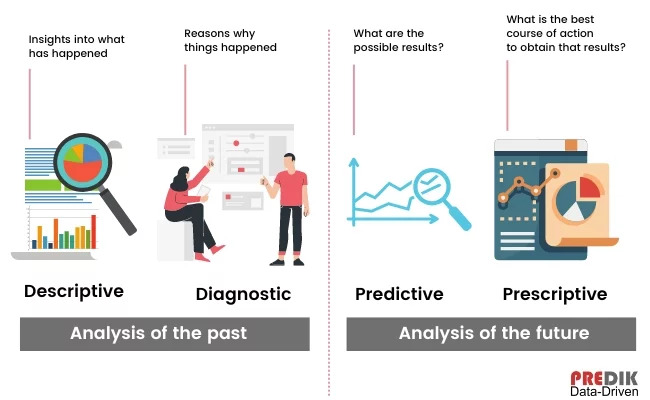
Image Source: Predikdata
Predictive Analytics vs Machine Learning
While predictive analytics is the overall process of forecasting future outcomes using data, machine learning is a subset of AI that automates model building within predictive analytics. Machine learning enhances predictive analytics by improving the accuracy of models over time.
Prescriptive vs Predictive Analytics
Predictive analytics forecasts future trends, while prescriptive analytics goes one step further by providing recommendations based on those predictions. Prescriptive analytics answers the question, “What should we do next?”
Descriptive vs Predictive Analytics
Descriptive analytics focuses on understanding past performance by analyzing historical data. Predictive analytics, on the other hand, uses that data to forecast future trends and behaviors.
Predictive Analytics vs AI
AI refers to the broader field of creating machines capable of performing tasks that typically require human intelligence. Predictive analytics is a specific application of AI, where data is used to forecast future events.
Predictive Analytics vs Predictive Modeling
Predictive modeling is a part of predictive analytics that involves building statistical models to predict outcomes. Predictive analytics encompasses a broader range of activities, including data collection, cleaning, and visualization.
How Key Differences and Interactions Impact Results?
The key difference between these concepts is their focus: descriptive analytics looks at past data, predictive analytics forecasts the future, and prescriptive analytics provides actionable recommendations based on predictions.
Descriptive analytics answers the question, “What happened?” while predictive analytics asks, “What will happen?”
Big data provides the fuel for predictive analytics, enabling businesses to analyze large volumes of information to detect patterns and make more accurate predictions.
Learning & Resources for Predictive Analytics
Courses and Training
A variety of online and offline courses offer training in predictive analytics, from introductory classes to advanced certifications.
Top Predictive Analytics Courses and Certifications
- Coursera: Offers courses in predictive analytics, including specialized programs from universities like Stanford and MIT.
- Udemy: Provides hands-on training for beginners and professionals alike.
- SAS Certified Predictive Modeler: A certification program for those looking to become experts in SAS’s predictive analytics software.
Online Predictive Analytics Training Options
Popular platforms for online predictive analytics training include:
- DataCamp
- edX
- Coursera
- Udemy
Certification Programs in Predictive Analytics
Certifications in predictive analytics can enhance career opportunities and include:
- Certified Analytics Professional (CAP)
- SAS Advanced Analytics Certification
- IBM Data Science Professional Certificate
Tutorials for Beginners and Advanced Users
Numerous online tutorials offer step-by-step guidance for beginners and advanced users alike. Platforms like Kaggle and Towards Data Science offer resources for learning predictive analytics techniques.
Advanced Educational Pathways
Advanced educational pathways in predictive analytics include master’s programs and specialized degrees in data science, machine learning, and AI.
Masters in Predictive Analytics
Universities like Northwestern and Penn State offer master’s programs in predictive analytics, designed to teach students advanced techniques in data mining, machine learning, and statistical modeling.
Key Institutions Offering Predictive Analytics Programs
Top institutions offering predictive analytics programs include:
- MIT
- Stanford University
- Harvard Business School
- Northwestern University
How Predictive Analytics Consulting Boosts Success?
Hiring Predictive Analytics Consultants
Predictive analytics consultants are data science experts who help businesses build and optimize predictive models. Their key roles include:
- Data Strategy Development: Creating effective data management and utilization strategies to derive actionable insights.
- Model Building and Validation: Designing custom predictive models and validating their accuracy for reliable predictions.
- Performance Optimization: Continuously refining models to enhance accuracy and align with evolving business goals.
When and Why to Choose Predictive Analytics Consulting?
Consider hiring predictive analytics consultants when:
- Leveraging Complex Data Sets: Navigating and analyzing diverse data sources for strategic insights.
- Developing Custom Predictive Models: Creating tailored models that address specific business challenges.
- Integrating Predictive Analytics: Ensuring predictive models work seamlessly within existing systems to boost efficiency.
How to Choose the Right Predictive Analytics Consultant?
When selecting a consultant, focus on:
- Industry Expertise: Look for experience in your industry to better address specific challenges.
- Relevant Experience: Ensure they have worked with similar data types and use cases.
- Technical Skills: Assess their proficiency in machine learning and predictive modeling techniques.
Predictive Analytics as a Service
Predictive analytics as a service (SaaS) enables businesses to access advanced predictive models through cloud-based platforms, making it easier to integrate and scale predictive analytics capabilities.
SaaS platforms provide predictive analytics solutions without the need for businesses to invest in costly infrastructure. These platforms are cloud-based, scalable, and customizable, making them ideal for businesses of all sizes.
Leading companies offer predictive analytics as a service, providing tools, expertise, and infrastructure to help businesses make better data-driven decisions. Services may include custom model development, data processing, and ongoing optimization.
Larger enterprises may require custom predictive analytics solutions tailored to their specific business needs. This involves working with consultants and vendors to build proprietary models that integrate seamlessly with existing systems and data sources.
How Predictive Analytics Transforms Industry-Specific Strategies?

Image Source: Sales-I
1. Healthcare and Life Sciences
Predictive analytics is revolutionizing the healthcare sector by enhancing patient outcomes and streamlining costs. By employing sophisticated predictive models, healthcare providers can address key challenges and improve overall service delivery.
- Predict Disease Progression: Predictive analytics enables healthcare professionals to analyze patient data and identify trends, allowing for the development of personalized treatment plans tailored to individual needs. This proactive approach can lead to better disease management and improved patient outcomes.
- Optimize Resources: By accurately predicting patient admission rates, hospitals can efficiently manage their resources, including staffing and equipment. This not only ensures that healthcare facilities are adequately prepared but also enhances the quality of care provided to patients.
- Reduce Readmissions: Predictive models can identify patients who are at high risk of readmission due to various factors, such as medical history or social determinants of health. By addressing these risk factors through targeted interventions, healthcare providers can significantly reduce readmission rates and improve patient safety.
Examples of Predictive Analytics in Healthcare
- Johns Hopkins University: This institution employs predictive analytics to forecast ICU admissions, enabling better preparedness and allocation of resources to meet patient needs.
- Geisinger Health System: By leveraging predictive models, Geisinger has enhanced chronic disease management, allowing for timely interventions and better patient support throughout their treatment journey.
How Predictive Analytics Improves Patient Outcomes and Reduces Costs?
By predicting patient outcomes, hospitals can allocate resources more efficiently, reduce the length of stay, and lower readmission rates, all of which contribute to significant cost savings.
2. Restaurants and Hospitality
Predictive analytics can enhance restaurant operations in several ways:
- Customer Demand: By analyzing trends, restaurants can forecast foot traffic, allowing for optimal staffing levels and tailored menu offerings during peak times.
- Menu Optimization: Identifying best-sellers through sales data enables targeted promotions, boosting sales and helping phase out underperformers.
- Supply Chain Management: Accurate demand forecasting ensures popular items are always in stock, reducing waste and maintaining a consistent customer experience.
Predictive Analytics for Restaurants: Menu and Staffing Optimization
By analyzing past sales data, weather conditions, and local events, restaurants can predict customer flow and adjust staffing levels and menu offerings to optimize profits and minimize waste.
3. Commercial Real Estate
Predictive analytics is used in commercial real estate to:
- Assess Risk: By analyzing historical data and market trends, predictive analytics helps stakeholders anticipate fluctuations in property values and identify potential investment risks. This enables investors to make informed decisions and develop strategies to mitigate risk exposure.
- Optimize Leasing Strategies: Predictive models can forecast tenant retention rates and demand for various types of spaces, allowing property managers to adjust their leasing strategies accordingly. This insight helps maximize occupancy rates and enhances revenue stability by ensuring that properties meet market needs.
- Improve Marketing: Leveraging predictive analytics, real estate professionals can tailor their marketing efforts to attract high-potential tenants. By identifying key demographics and preferences, targeted campaigns can be designed to engage the right audience, increasing the likelihood of successful tenant placements.
Predictive Analytics in Commercial Real Estate: Risk and Value Assessment
Real estate firms use predictive models to assess property values, forecast market trends, and predict tenant behavior, which helps investors make informed decisions about acquisitions and developments.
4. Pharmaceutical Industry
In the pharmaceutical industry, predictive analytics is used to:
- Accelerate Drug Development: Predictive analytics streamlines the drug development process by utilizing historical data and machine learning models to forecast the likelihood of clinical trial success. This allows companies to make informed decisions about which candidates to prioritize, reducing time and costs associated with development.
- Optimize Distribution: By analyzing market demand and supply chain logistics, predictive analytics ensures that drugs are distributed efficiently. It helps pharmaceutical companies identify the most strategic locations for distribution, allowing them to meet patient needs promptly and minimize stockouts or overstock situations.
- Improve Marketing: Predictive analytics enhances marketing strategies by providing insights into physician and healthcare provider behaviors. By segmenting target audiences and predicting their preferences, pharmaceutical companies can tailor their marketing efforts, leading to more effective outreach and engagement.
Predictive Analytics in Drug Development and Distribution
By analyzing historical data on drug development and clinical trials, pharmaceutical companies can predict which drugs are likely to succeed, optimizing research and development efforts.
Small and Medium-Sized Enterprises (SMEs)
Predictive analytics is helping SMEs to compete with larger companies by:
- Improving Efficiency: Automating inventory management and customer segmentation streamlines operations, reduces errors, and frees up teams for strategic tasks.
- Optimizing Marketing: Analyzing customer behavior data allows for targeted marketing campaigns, enhancing engagement and boosting conversion rates.
- Reducing Costs: Predictive maintenance prevents equipment failures, while demand forecasting minimizes excess inventory, leading to significant cost savings.
Predictive Analytics for Business Growth and Efficiency
SMEs can use predictive analytics to identify growth opportunities and streamline their operations. By understanding customer needs and market trends, they can allocate resources more effectively and increase profitability.
Future of Predictive Analytics with AI, ML, and Big Data
As AI and machine learning technologies advance, predictive analytics will become even more powerful. The integration of big data will enable businesses to make predictions with unprecedented accuracy and speed.
In the coming years, predictive analytics will continue to expand into emerging industries like smart cities, renewable energy, and autonomous vehicles, driving innovation and helping businesses stay ahead of the curve.
Predictive analytics is no longer a luxury reserved for large corporations. With affordable tools and cloud-based platforms, businesses of all sizes can now harness the power of predictive analytics to optimize their operations, enhance customer experiences, and stay ahead in an increasingly competitive market.
Conclusion
Predictive analytics is a powerful tool that enables businesses to forecast future outcomes, optimize operations, and make data-driven decisions. By leveraging machine learning, AI, and big data, businesses can gain valuable insights that give them a competitive advantage.
Throughout this guide, we’ve explored the fundamental concepts of predictive analytics, from its definition and key techniques to its applications across various industries. We’ve also reviewed the top predictive analytics tools and software platforms available to businesses of all sizes.
How to Leverage Predictive Analytics for Competitive Advantage?
To fully leverage predictive analytics, businesses should:
- Invest in the Right Tools: Selecting the right predictive analytics platforms is crucial. Businesses should evaluate various tools based on scalability, user-friendliness, and integration capabilities with existing systems. This ensures they can harness data effectively to meet specific business goals.
- Hire Skilled Professionals: Bringing in data scientists and predictive analytics consultants is essential for creating robust models. These experts can analyze complex data sets, uncover insights, and tailor solutions that drive strategic decision-making. Investing in training for existing staff can also enhance in-house expertise.
- Continuously Optimize: Predictive models should be dynamic, with regular testing and refinement to maintain their accuracy and relevance. Implementing a feedback loop where model predictions are compared against actual outcomes allows businesses to adjust their strategies proactively, ensuring they stay ahead of market changes.
Ready to put predictive analytics to work for your business? Sign up with JobsPikr today to access real-time, data-driven insights and discover the power of predictive analytics tailored to your needs.
